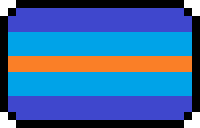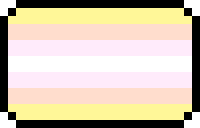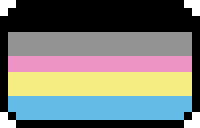
Multigender

Table of Contents

Multigender
Multigender is an umbrella term for someone who experiences more than one gender, though it can be used on its own as a gender identity. As there are infinite possible genders, the term multigender covers the infinite possible combinations of genders any person can potentially identify as. Terms such as genderfluid, genderflux, omnigender, pangender, polygender, and trigender fit under the label of multigender when used as an umbrella term. These genders all cover the experience of being more than one gender, and can be categorized as mutigender (though not everyone who identifies as one of these other labels will also identify as multigender).
The prefix "multi" means many. Combined with the word "gender" you get a word meaning "multiple genders."
The multigender flag has five horizontal stripes. The original creator of the multigender flag is unfortunately unknown as the account of whoever created it was deactivated. However, the flag featured here was posted to Deviant Art by the user "Pride-Flags" in January of 2016.

The two purple stripes at the top and bottom of the multigender flag represent being partially feminine and masculine at the same time.
The two blue stripes in the multigender flag represent partially identifying as masculine genders.
The center orange stripe in the multigender flag represents being partially a gender that is outside of the masculine-feminine spectrum.
Click to jump to external resources regarding the gender identity known as multigender.

Pangender
Pangender is a gender identity where someone experiences all genders, either simultaneously or shifting/changing/fluxtuating over time. Someone who is pangender may describe the experience of being pangender as any of the following; being an infinite spectrum, being very expansive and unspecific, having countless genders with no maximum limit, identifying as every gender possible, identifying as both polygender and more genders within their own culture and life experience, identifying as the entire gender spectrum, identifying as both binary genders and all known and unknown genders, identifying as all genders available, having an immense or uncountable number of genders, or having a gender experience that goes beyond all known genders.
The prefix "pan-" comes from the Greek root meaning all or everything. Combined with the word "gender" you get a word meaning "all genders". Note that someone who is pangender cannot claim to identify as genders that belong to cultures that they are not a part of (see [third genders] page for more information on culturally specific genders).
The earliest known mention of the term "pangender" comes from the book "The Flock", which was published in 1991. More specifically, from the preface written by Lynn Wilson, which says "Some gender-nonconforming individuals call themselves androgynes, pan-gender, or nonbinary.” This is clearly not the genuine origin of the word as it is referenced as a pre-existing word even in this text. Several sources reference the term pangender as being used in various Usenet groups back in the early 90s, though these forums are difficult to access these days. The term pangender likely originates from at least the late 80s, based on the nature of how long it takes for something like that to end up in a published novel.
The pangender flag consists of seven horizontal stripes that are symmetrical in color. The pangender pride flag was created in January of 2015 by tumblr user "pangendering" who helped popularize this nonbinary gender identity. The colors of the flag are very light due to white being the combination of all the colors. Pangender pride day is June 19.

The two light yellow stripes at the top and bottom of the pangender flag represent genders that are without reference to the gender binary.
The two light red stripes in the pangender flag represent transition to genders that are related to female and male.
The two light violet/pink stripes in the pangender flag represent a combination of female and male.
The center white stripe in the pangender flag represents a blend of all genders.
Click to jump to external resources regarding the gender identity known as pangender.

Polygender
Polygender is a gender identity wherin the person in question expriences more than one gender, either simultaneously or alternating between them. The genders experienced by someone who is polygender vary, and can cover any possible gender combination. The number of genders experienced by someone who is polygender can vary, someone who is polygender typically experiences 3 or more different genders.
The prefix "poly" means many. Similar to how a polygon refers to a shape with many sides, polygender refers to a person with many genders. While polygender is often considered interchangable with multigender, polygender is technically under the multigender umbrella. In some cases, polygender has been used as an umbrella term for those who exist outside of the gender binary.
The term polygender dates back to at least May 1995 when it was posted in "A Dictionary of Words for Masculine Women" written by Gary Bowen. In this list of words, polygender (written then as "polygendered") was listed as a synonym for pangender (written then as "pangendered"). The definition provided was "exhibiting characteristics of multiple genders, deliberately refuting the concept of only two genders." The original coiner for these words is unknown.
The polygender flag has five horizontal stripes. The creator of the polygender flag is unknown. Polygender pride day is June 20.

The black stripe at the top of the polygender flag represents being partially agender.
The grey stripe in the polygender flag represents fluctuating between genders.
The center pink stripe in the polygender flag represents femininity (including partial femininity).
The yellow stripe in the polygender flag represents genders outside the gender binary.
The blue stripe at the bottom of the polygender flag represents masculinity (including partial masculinity).
Click to jump to external resources regarding the gender identity known as polygender.

External Links

Multigender Resources
- Deviant Art: 01/17/2016: Pride-Flags: Multigender (2) (https://www.deviantart.com/pride-flags/art/Multigender-2-584880803) - origin of most commonly used multigender flag
- Dictionary - Multi (https://www.dictionary.com/browse/multi) - definition of the word multi
- Everyday Feminism: 02/09/2017: What Does Multigender Mean? 10 Questions You May Be Afraid to Ask – Answered (https://everydayfeminism.com/2017/02/what-it-means-to-be-multigender/) - article regarding multigender meaning and allyship
- Flag Color Codes - Multigender (https://www.flagcolorcodes.com/multigender) - blurb regarding multigender flag
- LGBTQIA - Fandom - Wiki - Multigender (https://lgbtqia.fandom.com/wiki/Multigender) - crowdmade wiki regarding multigender meaning, history, and similar identities
- Nonbinary - Wiki - Multigender (https://nonbinary.wiki/wiki/Multigender) - wiki regarding multigender meaning and similar identities
- Planned Parenthood: 01/20/2023: Is it normal to feel like multiple genders? (https://www.plannedparenthood.org/blog/is-it-normal-to-feel-like-multiple-genders) - blog post about identifying as multiple genders
- Reddit - r/Multigender (https://www.reddit.com/r/Multigender/) - subreddit for those who are multigender
- Spectrum ID - Multigender (https://spectrum-id.com/multigender.html) - article regarding multigender meaning and allyship
- Trans Language Primer - Multigender / Polygender (https://translanguageprimer.com/multigender/) - blurb regarding the terms multigender and polygender

Pangender Resources
- Daily Dot: 05/19/2021: Collyn Burke: What it means to be pangender (https://www.dailydot.com/irl/pangender-definition-pronouns/) - article regarding the meaning of pangender
- Definitions - Pangender (https://www.definitions.net/definition/PANGENDER) - definition, pronunciation, and translation of pangender
- Dictionary: 07/01/2019: Pangender (https://www.dictionary.com/e/gender-sexuality/pangender/) - article regarding pangender meaning and history
- Divers Magazin - Pangender (https://diversmagazin.de/glossar/pangender/) - this resource is in German
- Gender - Fandom - Wiki - Pangender (https://gender.fandom.com/wiki/Pangender) - crowdmade wiki regarding pangender meaning, related terms, flags, symbols
- Goodreads: 06/04/1991: Joan Frances Casey & Lynn Wilson & Frances Howland: The Flock: The Autobiography of a Multiple Personality (https://www.goodreads.com/book/show/676493.The_Flock) - the preface of this book, written by Lynn Wilson, contains the earliest known mention of the word pangender "Some gender-nonconforming individuals call themselves androgynes, pan-gender, or nonbinary.”
- Identidad y Genero - pangendero (https://identidadygenero.com/pangenero/) - this resource is in spanish
- Into More: Eloisa De Farias: What Does It Mean to be Pangender (https://www.intomore.com/culture/identity/what-does-it-mean-to-be-pangender/) - article regarding pangender meaning, usage, history, self discovery, and fictional characters
- LGBTQIA - Fandom - Wiki - Pangender (https://lgbtqia.fandom.com/wiki/Pangender) - crowdmade wiki regarding pangender meaning, history, and similar terms
- LGBTQIA - Wiki - Pangender (https://lgbtqia.wiki/wiki/Pangender) - wiki regarding pangender meaning, alternate flag, and symbols
- Nichtbinär-Wiki - Pangender (https://nibi.space/pangender) - this resource is in German
- Nonbinary Wiki - Pangender (https://nonbinary.wiki/wiki/Pangender) - wiki regarding pangender meaning, usage, history, and fictional characters
- Pridely Gay: 09/14/2022: Gay Worlley: What Is Pangender? (https://pridelygay.com/what-is-pangender/) - article explaining pangender
- Pride Planet - Pangender (https://prideplanet.de/flag/pangender/) - this resource is in German
- Reddit - r/pangender (https://www.reddit.com/r/pangender/) - subreddit for pangender
- Simple Wikipedia - Pangender (https://simple.wikipedia.org/wiki/Pangender) - simple wikipedia article regarding pangender
- Spectrum Id - Pangender (https://spectrum-id.com/pangender.html) - article regarding pangender usage, meaning allyship
- Trans Language Primer - Pangender / Omnigender (https://translanguageprimer.com/pangender/) - blurb about the terms pangender and omnigender
- Tumblr: 01/28/2015: pangendering: Possible pangender pride flags: I’ve been trying to come up with pangender pride flags, so here are the ones I created (https://www.tumblr.com/the-transgenda-agenda/785819270013665280/possible-pangender-pride-flags) - original pangender pride flag
- Tumblr - Pangendering (https://pangendering.tumblr.com/) - blog that helped popularize the term pangender
- Vrouwuitdekast - Pangender - this resource is in Dutch

Polygender Resources
- Deviant Art: 06/04/2015: Pride-Flags: Polygender (1) (https://www.deviantart.com/pride-flags/art/Polygender-1-543925900) - earliest online posting of polygender flag, creator unknown
- Gender - Fandom - Wiki - Polygender (https://gender.fandom.com/wiki/Polygender) - crowdmade wiki regarding polygender meaning, history, and alternate flag
- LGBTQIA - Fandom - Wiki - Polygender (https://lgbtqia.fandom.com/wiki/Polygender) - crowdmade wiki regarding polygender meaning, history, flag meaning, and similar terms
- Nonbinary Wiki - Polygender (https://nonbinary.wiki/wiki/Polygender) - wiki regarding polygender meaning and usage
- Pride Corner - Polygender (https://www.pridecorner.org/glossary/polygender) - article regarding polygender meaning, usage, and allyship
- Pride Flag Guide - Polygender (https://flag.library.lgbt/flags/polygender/) - blurb regarding polygender flag color codes and meanings
- Queer In The World: 10/14/2023: Cecilia Miller: What Does Polygender Mean? + Other Polygender Information To Help You Be A Better Ally! (https://queerintheworld.com/what-does-polygender-mean/) - article regarding polygender meaning and allyship
- Simple Wikipedia - Polygender - simple wikipedia page for polygender
- Spectrum Id - Polygender (https://spectrum-id.com/polygender.html) - article regarding polygender meaning, usage, flag, and allyship
- Wayback Machine: 05/15/1995: Gary Bowen: A Dictionary of Words for Masculine Women (https://web.archive.org/web/19961105010926/http://www.ftm-intl.org/Wrtngs/ftm-words.gary.html) - list of words and definitions. includes the words polygendered/pangendered
- Wayback Machine: 05/26/1998: Danica Nuccitelli: A Queergendered FAQ (https://web.archive.org/web/20200204005048/http://gender-sphere.0catch.com/polygenderfaq.htm) - 1: What does it mean to be polygendered?

